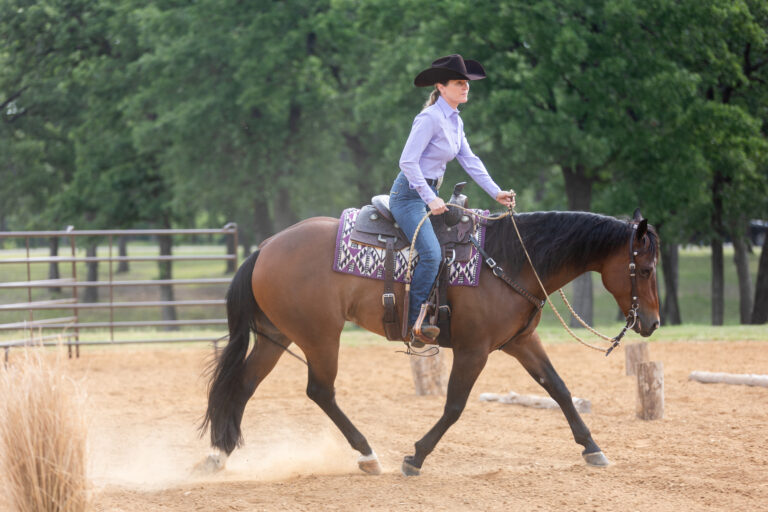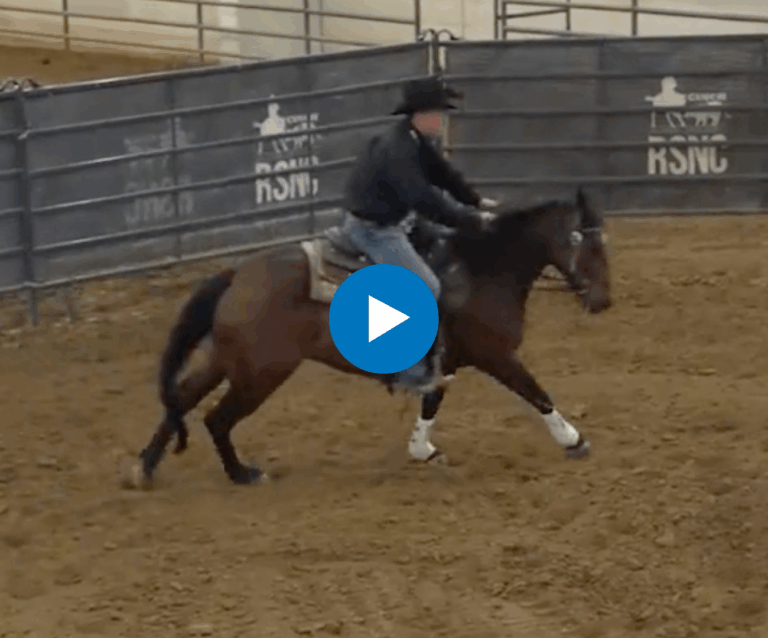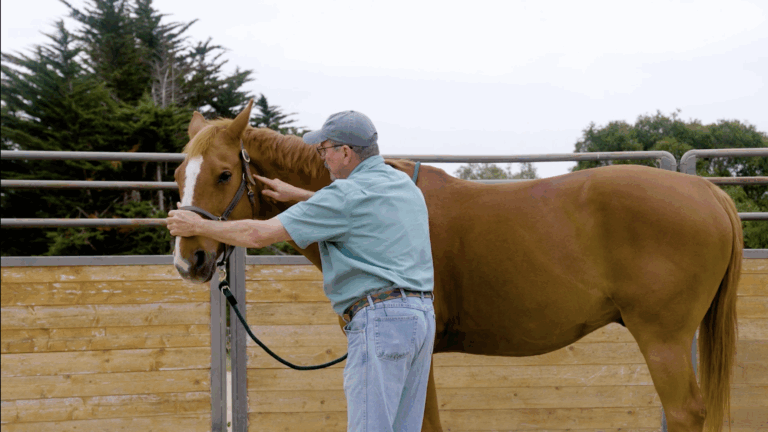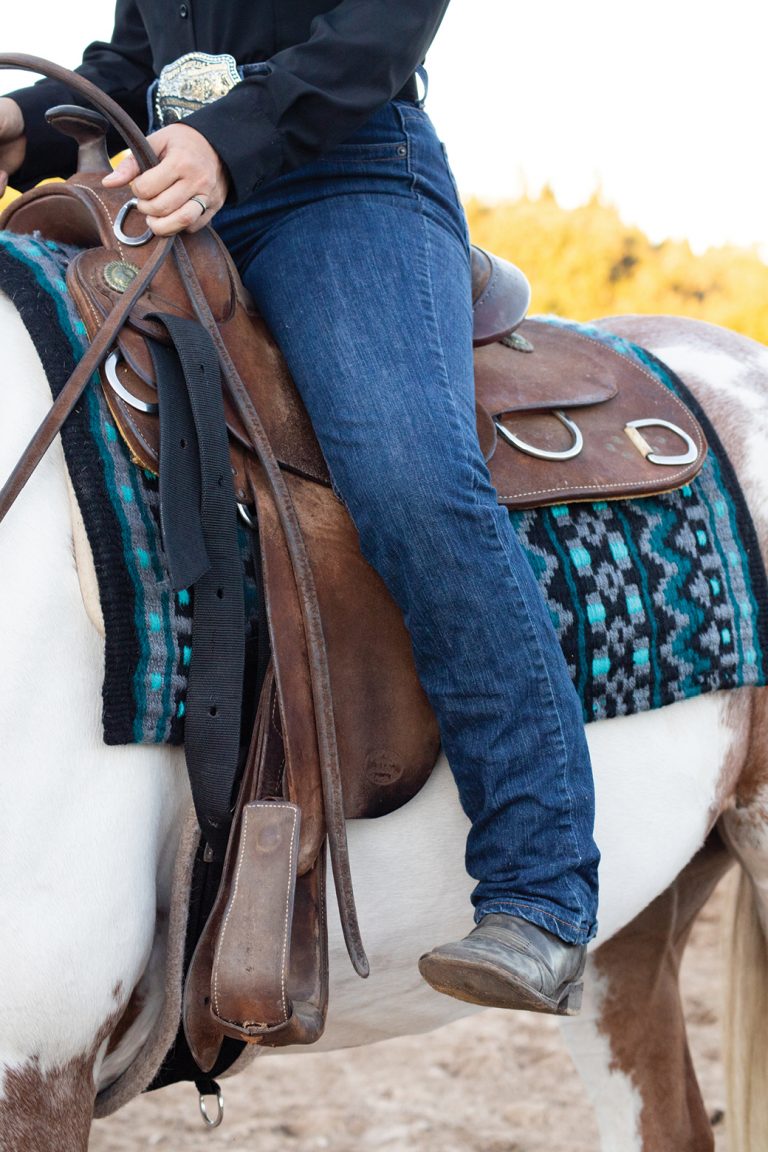Working the flag is an essential training tool when you ride cow horses or cutting horses, but did you know it can also help your horse develop basic skills he needs for other aspects of riding? Flag work has everything to do with cow work, and nothing to do with cow work. It teaches your horse how to better read a cow, but it also teaches him control, how to move his body around, and how to listen for your leg, hand, and seat cues independently.
I’m going to cover the different ways flag work can help your horse, even if you never have plans to work a cow. Then I’ll talk about some of the most common problems I see during flag work and the different drills you can use at home to correct them.

Benefits of Flag Work
A lot of people think that if they never have plans to do a cattle event that there’s no point in teaching their horse how to work a flag. But I’m here to tell you that’s not true. Flag work is a great way to reinforce basic riding fundamentals and ensure your horse is listening to your cues and body language.
Move his feet. Having control over your horse’s feet is very important, even if you never work a live cow. Being able to move your horse’s feet can keep you from getting into trouble both in the arena and outside of it. For example, if you come across a water crossing on a trail and your horse balks at it, having control of his feet can keep you from getting stuck in a bad situation. It can also help with going over different obstacles you might find during your ride.
More from Brad: Know Your Horse’s Limits
Leg and seat cues. Your horse needs to respond to your leg and seat cues, and working the flag is a great way to test that. When you trot your horse parallel to the flag, you’re using your legs and your seat to push him forward. When it comes time to stop, you release your legs away from him, drop your heels, and sit deep in your seat. If your horse is paying attention to the flag, he should be stopping when it stops, but your leg and seat cues will help reinforce this.
Rein cues. Your horse also needs to be responsive to your rein cues when you work a flag. If you ask him to stop and he doesn’t respond to your leg and seat cue, the next step is using your hand. You need to know that he’ll be responsive when you do go to your reins. You also use your reins to help guide your horse when you make a turn, which will help him learn how to follow his nose and understand direct and indirect rein cues.
Keep him responsible. A flag keeps your horse responsible. It causes him to pay attention to what he’s doing and where he’s going. When the flag stops, he should stop. When the flag goes the opposite direction, he should turn and stay parallel with the flag. While you should have control of his feet, you don’t want to have to micromanage every step he takes.

Different Drills
Whether your horse is a seasoned pro on the flag or still in the beginning stages, there are a few different drills you can incorporate into your riding program to solve common problems that happen on the flag.
But before you start, make sure that you safely introduce your horse to the flag so you can get the most out of your training session.
Once you’ve done that, it’s time to put your skills to the test.
Get him hooked. Before you begin doing anything with your horse on the flag, give him the chance to get hooked onto it, especially if he’s green. This warmup is also the time to assess what he’s doing and figure out what drills you need to include in your training session for that day.
Start by having the flag go long on both sides so your horse has some time to hook onto it. If he’s familiar with the flag and has experience tracking it, you can start mixing it up on him after he’s hooked on. Go long, go short, and go the same direction. (This is where you stop the flag and then start it again going the same direction you were before.)
Learn More: Flag Work Fundamentals
Constant collection. Do you find your horse coming out of the bridle when you stop or turn to go the other direction? That means he’s probably not staying collected during the stop and through the turn. It also means he’s probably not collected when you’re trotting him prior to stopping.

To fix that, you need to work on framing him up in the trot before you even ask to stop. Pick up your rein hand and use your feet to push your horse through the bridle to release from the pressure of the bit, and put his neck and chin down so that he’s not pulling against your reins.
When you ask for the stop, release your feet like you normally would but keep your hand up. Once he’s fully stopped, you can use your feet to reinforce him breaking at his poll. Don’t let him back up or walk forward during this process. He needs to stay still when you’re framing him up.
If he’s still pulling on your hands, or is getting heavy on the bridle, create energy with your hands and bump the reins rather than just holding them.
Your horse’s neck should also have a slight arc to it on his cow side when he’s framed up, so that he’s in a better position to turn.
Follow his nose. If you’re working with a green horse, he needs to learn how to follow his nose, regardless of what you plan on doing with him. When first teaching this, start him two-handed in a snaffle bit.
Ride forward like you normally would. When the flag stops and starts to go the opposite direction, use your direct rein, and encourage your horse to follow his nose through the turn. If he follows that direct-rein cue and gets turned around quickly, continue to move with the flag and test the other direction out.
If your horse is sluggish or his feet are going everywhere, don’t leave the turn, but instead do two or three turns before catching back up with the flag. Take your direct rein and keep it near your belt loop or hip pocket to encourage your horse to turn. If he gets stuck or just isn’t moving quick enough, go to your feet and encourage more movement.
His hips should stay somewhat still during this drill, like you would in a regular turnaround. If he’s twirling around or is not coordinated with where he’s putting his feet, you can use your indirect rein to support the hip and keep it from moving around as much.
When you leave the turn, straighten your horse out, and then let him catch up to the flag. When you stop again, you’ll turn the opposite direction and do the same thing.
Hold him accountable. If your horse isn’t stopping when the flag stops, hold him accountable. Let him make the mistake of going long; once you complete your turn, you can ask him to hurry up, so he’s caught up with the flag.
When the flag stops the next direction, you’re going to do the same thing. Let him go long, stop him with your feet, make the turn, and then ask him to move quickly so he gets back to the flag before it stops again. Eventually he’ll figure out he doesn’t have to work so hard if he reads the flag and stops and turns when he’s supposed to.
Eliminate drifting. Sometimes drifting happens going one way, and not the other. Other times, it happens both directions. To fix it, you need to give your horse a reason to stay with the flag—similarly to what you did when you were holding him accountable.
If your horse wants to drift away from the flag and not pay attention to it, let him. Once you stop and make the turn, then it’s time to establish a sense of urgency and have him catch back up with it. When he starts to drift going the other direction, you’ll do the same thing.
Eventually he’ll realize it’s more work for him if he drifts away from the flag and stop long, and to make it easier on himself he’ll start watching the flag a little more and trying to stop when it stops.
If your horse only drifts going one direction, reward your horse by giving him time to rest on the side that he wants to stay up against the flag.
Better With Friends
Don’t have a flag at your place? No problem! Working the flag is a great activity to do with your closest riding friends, which is exactly what Esther Peterson did when she found out she won the Brad Barkemeyer Win-a-Day contest brought you by Horse&Rider, Weaver Leather, and Equimax. After originally winning the contest in 2020 during the pandemic, Brad and the H&R crew were finally cleared to head to Bozeman, Montana, and put on a cow horse clinic for Esther and nine of her friends.
The day of the clinic, the group was ready to get to work. We started the day by working on Brad’s favorite perfect circle exercise, before moving on to stopping drills. For lunch everyone gathered around to enjoy some local barbeque while Brad went over the prizes our clinic participants were receiving from Weaver Leather and Equimax.
Watch: Introducing a Rider to the Flag
Then it was time to head back out to the barn to spend the rest of the afternoon working the flag and enjoying each other’s company. Making this clinic definitely worth the wait.





